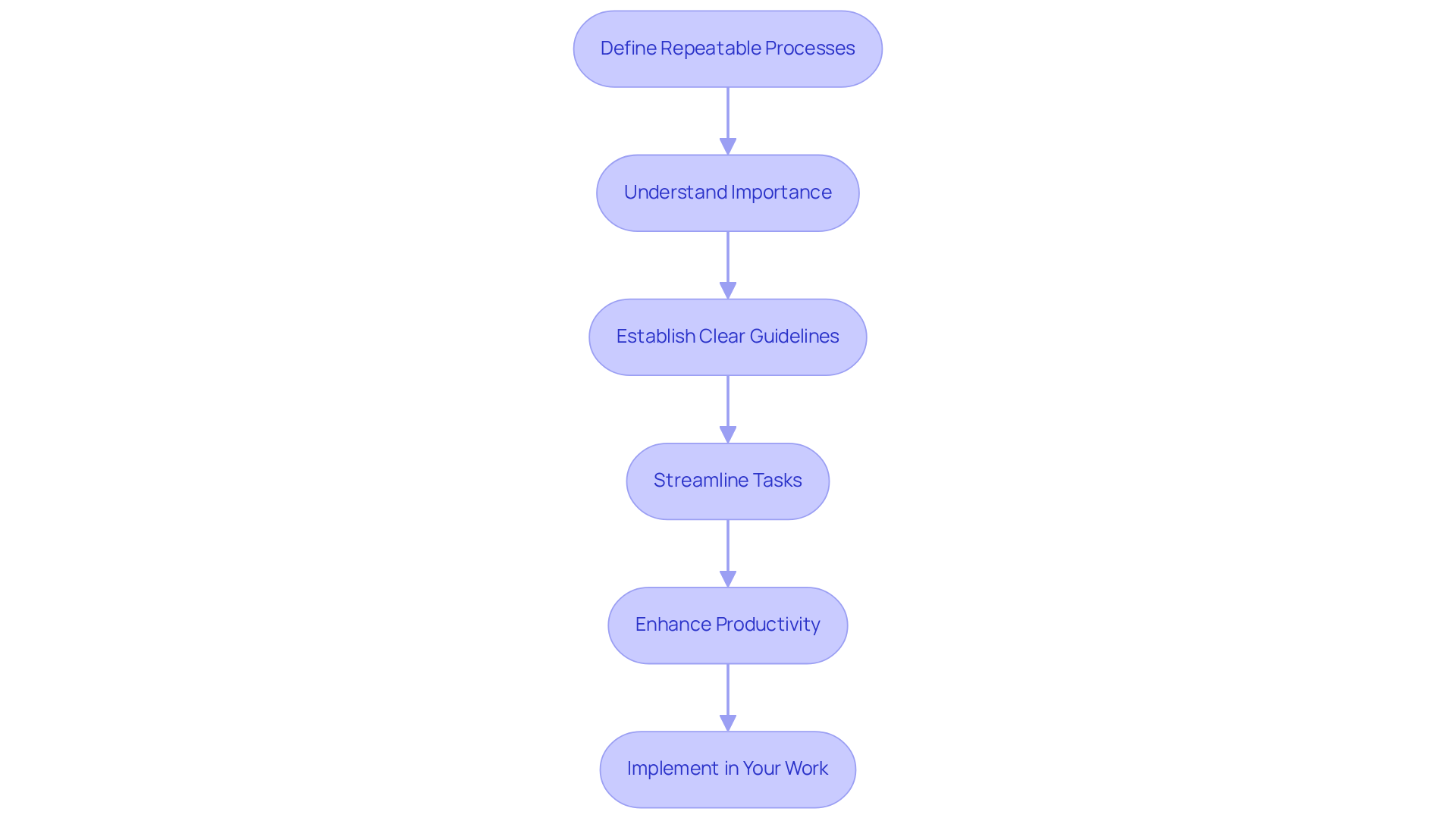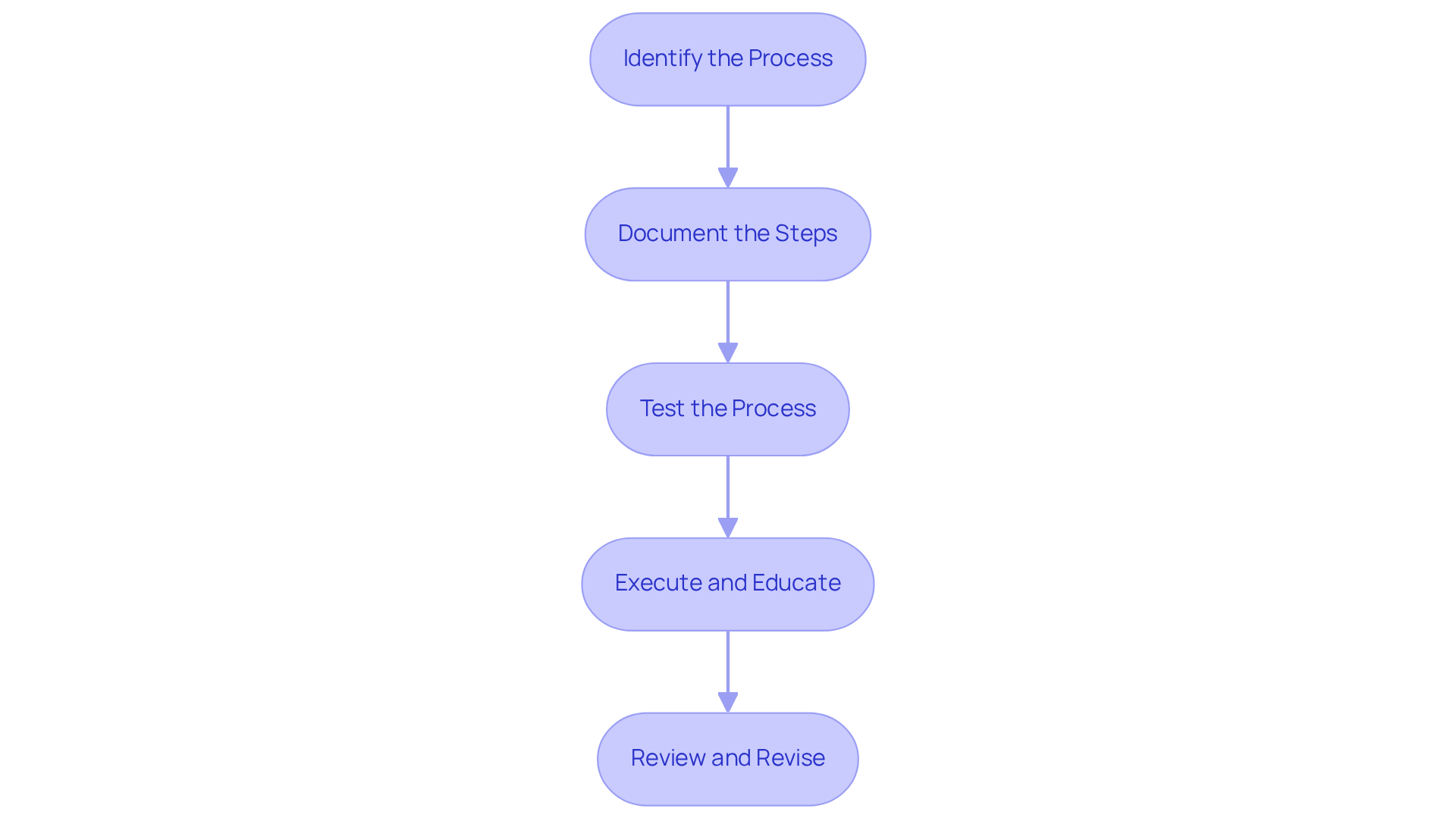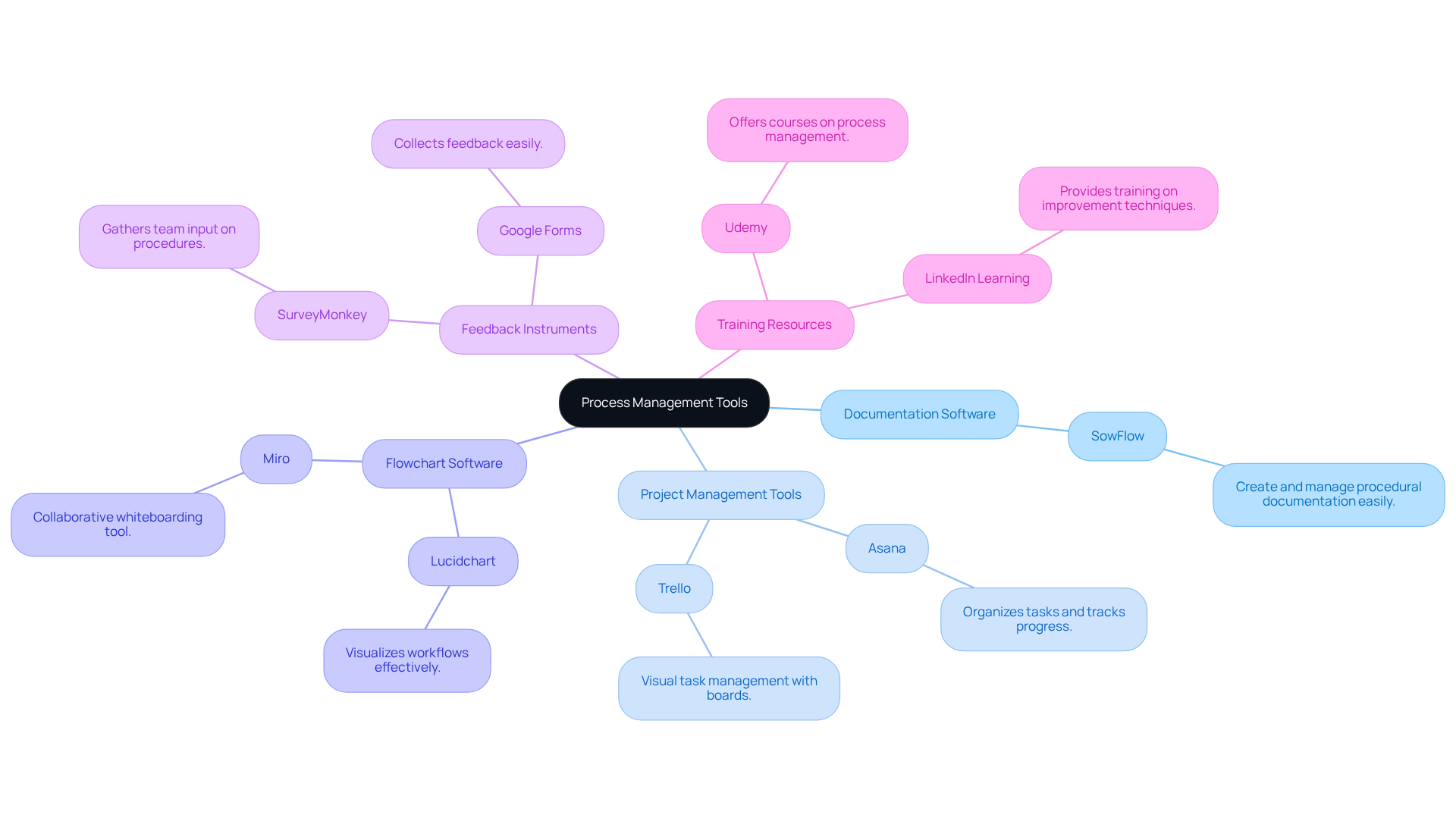
Overview
You might be wondering how to create a repeatable process for your team. Well, it’s all about following four key steps:
- Identify the process
- Document the steps
- Test the process
- Execute while educating the team
Sounds simple, right? The article points out that clear documentation and regular reviews are super important for cutting down on errors and boosting productivity. Plus, it addresses challenges like resistance to change by emphasizing the need for effective communication and training. So, let’s dive into how you can make this work for you!
Key Highlights:
- Repeatable processes are systematic sequences of actions that ensure consistent task execution, reducing errors and boosting productivity.
- Clear guidelines help teams tackle tasks efficiently, improving work quality and saving time.
- Key steps to create a repeatable process include identifying the process, documenting steps, testing, executing, and reviewing.
- Challenges in implementing repeatable processes include resistance to change and unclear documentation; effective communication and engagement can mitigate these issues.
- Training sessions can boost productivity by familiarising team members with new procedures and easing fears about change.
- Monitoring progress and being open to feedback are crucial for refining processes and ensuring they meet organisational needs.
- Useful tools for managing repeatable processes include documentation software, project management tools, flowchart software, feedback instruments, and training resources.
Introduction
You might be wondering why establishing effective workflows is so crucial for your team. Well, let me tell you—it’s all about boosting productivity and cutting down on those pesky errors. Think of repeatable processes as the backbone of your organizational efficiency. They help your team tackle tasks consistently and with a lot more ease.
But here’s the kicker: creating these streamlined methods isn’t always a walk in the park. So, how can your team successfully implement repeatable processes that not only improve operations but also nurture a culture of continuous improvement? Let’s dive into that!
Define Repeatable Processes and Their Importance
You might be wondering what a truly entails. Well, they’re basically that form a repeatable process you can carry out consistently to get the results you want. These methods are super important for organizations because they help ensure that through a repeatable process, which cuts down on errors and . By laying down , teams can create a repeatable process that allows them to tackle tasks more efficiently, saving time and .
For instance, think about . Having a consistent way to handle inquiries can really and make customers happier. So, grasping the significance of these procedures is just the first step! Once you understand that, you can start executing them effectively within your group. Now, let’s dive into how you can in your own work!

Steps to Create a Repeatable Process
- Identify the Process: You might be wondering where to start. Choose a task that your team often tackles, like or handling customer inquiries, which can be turned into a . This first step is key because it makes sure your approach is relevant and really hits home. With SowFlow, you can easily whip up that lay out these processes, giving your team quick access to the resources they need.
- Document the Steps: Now, let’s break that task down into . Think bullet points or flowcharts to illustrate the procedure—keeping it straightforward and easy to follow is crucial. SowFlow makes it a breeze to create user guides, allowing for quick updates and revisions to keep everything fresh. Remember, 46% of workers in small to midsize companies say they every day, so are a must!
- Test the Process: Before you wrap up those records, why not do a trial run with a teammate? This is your chance to spot any hiccups or areas that need a little tweaking. Gathering feedback at this stage is super important; it helps you refine the process and ensures it’s user-friendly. With SowFlow’s instant record-keeping solution, , letting you make adjustments based on real-time feedback.
- Execute and Educate: Once you’ve nailed down the procedure, it’s time to get your . Share the documentation created through SowFlow and encourage them to ask questions—this boosts understanding and confidence in the new method. Not only does this improve group efficiency, but it also aids in onboarding new members.
- Review and Revise: Don’t forget to check in regularly on the system to keep it relevant and effective. Make changes based on team feedback and evolving needs, ensuring the procedure stays aligned with what the organization requires. This ongoing approach not only ramps up productivity but also creates a repeatable process that helps with employee retention, as 43% of employees might think about leaving a job that doesn’t have .

Overcome Challenges in Implementing Repeatable Processes
Establishing consistent methods often runs into a few bumps in the road, right? You know, things like and unclear documentation can really throw a wrench in the works. So, how can we tackle these challenges effectively? Let’s explore some strategies together:
- Express Clearly: Have you thought about how important it is to explain the perks of the new method to everyone in the group? Using meetings and written communications to show how the changes will is key. A McKinsey report even says, "86% of employees believe automation will help them do their work more efficiently," so let’s not underestimate clear communication!
- Engage the Group: You might be surprised at how much insight your group members can offer when they’re included in the creation of the workflow. Their input is invaluable, fostering ownership and increasing buy-in for the . After all, resistance to change can really slow down efforts, making participation essential.
- Provide Training: What about conducting some ? This not only helps everyone get familiar with the new procedure but also eases fears and builds confidence in executing the steps effectively. A study suggests that organizations see in tasks that have been automated, highlighting the benefits of solid training.
- Monitor Progress: Now, once you’ve implemented the new procedures, it’s crucial to keep an eye on how things are going. using key performance metrics can help evaluate its effectiveness and make necessary tweaks for better outcomes. Research shows that 60% of organizations achieve ROI within 12 months of implementing workflow automation, so monitoring is definitely worth it!
- Be Open to Feedback: Have you created a space where your colleagues feel comfortable sharing their experiences with the new system? Consistently asking for input can help you continually improve and adjust the system, ensuring it meets the evolving needs of the team. This kind of openness can significantly reduce resistance to change and enhance the execution of a repeatable process.
By embracing these approaches, organizations can significantly reduce resistance to change and enhance the of a repeatable process. So, what do you think? Ready to give it a try?

Utilize Tools and Resources for Effective Process Management
To effectively manage a repeatable process, you might be wondering what could assist. Let’s explore a few options that can make your life easier:
- First up, we have . Tools like you create and manage without a hitch. They make it super easy to update and share info with your team.
- Next, consider . Platforms like Asana or Trello are great for organizing tasks and keeping track of progress on those repeatable processes. They ensure everyone stays accountable and in the loop.
- Now, let’s talk about . Using tools like Lucidchart or Miro can help you visualize workflows. Flowcharts simplify things, making it easier for everyone to grasp those intricate processes.
- Don’t forget about ! Tools such as SurveyMonkey or Google Forms are perfect for gathering input from your team about the procedures. This feedback can be invaluable for developing a repeatable process to refine and improve your processes over time.
- Lastly, think about . Online platforms like Udemy or LinkedIn Learning can provide your team with additional training on and improvement techniques. It’s a great way to boost everyone’s skills and confidence!
So, which of these tools do you think would be the most helpful for your team? Let’s dive into how you can implement them!

Conclusion
You might be wondering why establishing a repeatable process is such a big deal for your team’s efficiency and productivity. Well, it’s all about creating systematic sequences of actions that help minimize errors and streamline workflows. This leads to consistent results, which is something every team strives for! Understanding the importance of these processes is your first step toward building a structured approach that benefits both your team and the entire organization.
Now, let’s dive into a handy four-step guide to developing those repeatable processes:
- Identify the task
- Document the steps
- Test the process
- Execute with education
Of course, challenges might pop up along the way, like resistance to change, but don’t worry! Clear communication is key. Engaging team members, providing training, and keeping an eye on progress can help you overcome these hurdles and ensure your processes stay effective and relevant.
In conclusion, adopting repeatable processes doesn’t just boost productivity; it also nurtures a culture of continuous improvement and adaptability within your teams. By using the right tools and resources, your organization can really enhance operational efficiency and employee satisfaction. Embracing these practices is essential for any team looking to thrive in a competitive environment. So, taking action to implement and refine those repeatable processes is a pivotal step toward achieving long-term success. What steps will you take next?
Frequently Asked Questions
What is a repeatable process?
A repeatable process is a systematic sequence of actions that can be consistently carried out to achieve desired results.
Why are repeatable processes important for organizations?
Repeatable processes are important because they ensure tasks are completed consistently, reduce errors, and boost productivity. They provide clear guidelines that help teams work more efficiently.
How can repeatable processes improve the quality of work?
By establishing clear guidelines and methods, repeatable processes allow teams to tackle tasks more efficiently, which saves time and enhances the overall quality of their work.
Can you provide an example of a repeatable process?
An example of a repeatable process is a consistent method for handling customer support inquiries, which can streamline responses and improve customer satisfaction.
What is the first step in implementing repeatable processes within a team?
The first step is to understand the significance of repeatable processes, which will help in executing them effectively within the group.
👍
What others are liking
5 Steps to outline your ideal documentation structure
5 MINS READ
Where to start the your journey of mapping out your ideal documentation structure, aligning it with the very heartbeat of your organization?
Defining a winning level of detail in your process
3 MINS READ
What is too much detail, and what is too little? This article described in that winning level detail about what detail is enough.





